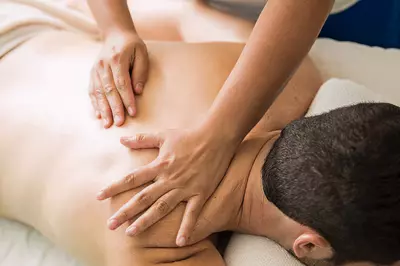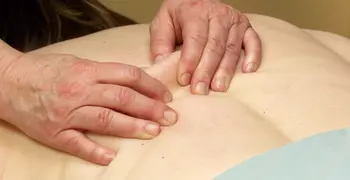Massage for Healing

Massage is a wonderful way to strengthen the mind-body connection, alleviate tension and pain, and deepen your relaxation. But what exactly is massage, and how does it work?
What is massage?
Massage therapy is the physical manipulation of soft tissue, which includes muscle, connective tissue, tendons, ligaments, and skin. What makes it especially versatile is how easily it can be tailored: therapists can adjust the pressure, depth, and technique to suit your individual needs and preferences.
Massage can vary
While the benefits of massage are widely recognized, it’s important to note that massage therapy is not a one-size-fits-all experience; in fact, it can vary in several significant ways.
There are different types of massage therapy. The most common types referred to in Western countries are Swedish or classical. Other styles include sports massage, clinical massage, and massage styles coming from Eastern traditions such as Shiatsu (Japan) and Tuina (China).
- If you receive massage in the hospital or clinic setting, it will often be a targeted clinical massage, which focuses on a specific area of the body, rather than full-body massage.
Targeted clinical massage is typically much shorter in duration than full-body massage for relaxation or general preventative wellbeing.
- Massage therapy is easily adaptable to accommodate the needs and preferences of the recipient. You can receive a massage when seated, lying face up or face down. It can be done over clothing or directly on the skin. The most important factors are your safety and comfort.
How massage can help
Now that we’ve explored the many forms massage can take, let’s look at some of the most common reasons people seek it out and how it may support your wellbeing.
You might explore massage therapy for a variety of reasons. Most commonly, people get massage therapy for musculoskeletal pain, jaw pain, edema, constipation, headache, and emotional and mental wellbeing.
Where to get a massage
Understanding how massage can help is just the first step-next, it’s important to know where you can access the therapy safely and effectively. A variety of clinical settings offer massage, including inpatient hospital units, clinics, integrative practitioner offices (chiropractic, TCM, osteopathic), and rehabilitation clinics. Massage is widely available, but the massage therapist’s level of training and experience can vary, so it is important to know and understand what they can offer and if it meets your needs.
Massage for self-care
Beyond professional settings, massage can also be a meaningful way to care for yourself at home.
Before you start It is important to consider potential causes of your discomfort and explore other strategies to relieve it. Here are some simple, practical strategies to help:
- Positioning Are you sitting at a desk, computer, on the couch, or in bed all day? If you can, mix up your position throughout the day to distribute your muscles workload this may improve discomfort. Alternating between rest and activation will also help.
- Stretching Your legs and back may be tight so give them some love! From a standing or seated position bend forward towards your toes to stretch out the long muscles of your legs and back. This should not hurt, so don’t push it too far. Bend your knees if you get uncomfortable.
- Posture When you are standing up or sitting down take a few deep breaths and pull your shoulders up to your ears and roll them back to help realign your posture. Also, remember to firm up and contract your abdominal muscles to help support your spine.
If you’re ready to try massage on your own, a few simple techniques can make a real difference.
Getting Started
Before you begin, it helps to understand where tension tends to show up and how to approach those areas safely and effectively.
Soreness and muscle tension are common issues that many of us experience. Whether you have an active lifestyle and are physically active or you are worn out and fatigued from treatment, you can learn a few massage techniques to enhance your wellbeing. When performing massage on yourself it is important to think about what you can actually reach and do comfortably and what you may need a tool for to help you. Easily accessible locations include your head, hands, feet, and stomach. Tools are an option for hard to reach or difficult areas like your neck, back, and legs.
As you begin, one of the most important things to keep in mind is how much pressure to use.
Pressure
The goal is to use as much pressure as is enjoyable and eases muscle tension (and NOT to apply as much pressure as you can tolerate).
Here are some tips:
- Massage can vary from very light pressure to deep pressure.
- When applying pressure start with light pressure and gradually increase as tolerated.
- Pressure should be noticeable but not painful or uncomfortable.
- Too much pressure can increase muscle tension and stress.
- Avoid deep, unrelenting tissue pressure.
- Avoid aggressive friction when applying pressure, i.e., excessive rubbing.
Tools
In addition to your hands, various tools can enhance your massage experience, but it’s important to use them gently.
There are many types of tools to use for massage, but be aware that you want to err on the side of light pressure to avoid tissue damage.
- Hand gloves and rolling balls provide an even distribution of pressure and are easy to use.
- Canes are good for reaching those hard to get areas like your back, neck, and feet.
- Foam rollers are another option for an even distribution of pressure. They are especially effective for your legs, back, and glutes.
While many people benefit from massage therapy, it is important to be aware of potential safety concerns and know when precautions are necessary.
Safety precautions
Make sure you are addressing safety concerns and seek guidance from your healthcare team if you have any questions or concerns.
Make sure the therapist knows your medical situation
There are a few safety precautions to take into consideration when providing or receiving massage.
If you are receiving a massage from a professional massage therapist (even if they are a family member or friend), make sure they are aware of any medications or treatments you have received or are currently receiving. This is because certain medications like blood thinners, blood pressure medication, chemotherapy, or radiation will impact your body’s tolerance of massage and could put you at greater risk for harm. If they are unfamiliar with your medication and treatment plan, they should not do massage and you should seek guidance from your healthcare team.
When to avoid massage
While massage is safe most of the time, there are instances when it should be avoided or delivered with caution. If you do get a massage in any of the situations listed below, the therapist should adjust the amount of pressure and length of massage accordingly.
- Broken, irritated, or blistered skin
- Deep Vein Thrombosis
- Cancer bone metastases
- Low platelets, increased INR or clotting disorder
- Neurological immaturity (infants, spina bifida)
Precautionary sites
Massage to the following areas is not recommended. If you or a massage professional choose to proceed with massage in these areas, use extra caution.
- Around the eyes
- On the neck, below jaw and earlobe
- Armpits
- Inside bend and outside of elbow
- Kidney region of the low back
- Belly button area
- Groin area
- Behind the knee
Note that therapists should exercise caution with lymphedema or excessive fluid overload, edema, and third spacing. During pregnancy, you should only get a message from a specialized massage therapist.
Letter for a massage therapist
If you decide to pursue massage therapy and want your massage therapist to understand your needs and medical background better, providing clear communication is essential.
We recommend you bring this letter to the massage therapist to give them an idea of the precautions they should take. Feel free to add any additional precautions that are specific to you. Click on the button below to download a PDF for you to use.



